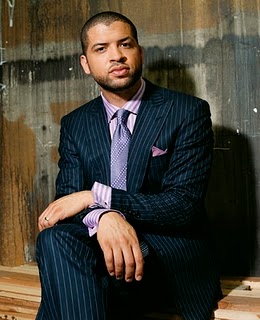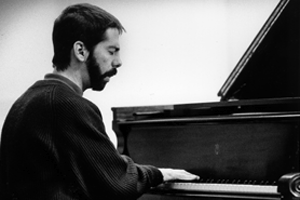Jazz Review: Two Marvelous for Words — Fred Hersch and Jason Moran
I cite the repertoire only to give you a sense of the breadth of the material Jason Moran and Fred Hersch built on. The glory of the evening was the complete integration of the two pianists’ musical thought.
By Steve Elman

Pianist Jason Moran — His big, powerful fingers seem capable of giving a distinct shape to every note in an arpeggio, no matter how fast he’s going.
“Rapport” isn’t good enough to describe what a crowd of 600 witnessed in Jordan Hall on Tuesday March 8. “Coalescence” isn’t right either. “Symbiosis”? “Syncresis”?
Whatever it was, it was dazzling. Pianists Fred Hersch and Jason Moran treated us to a display of musical cooperation that was among the most satisfying I’ve ever heard.
Hersch is known for an elegance of touch, an orchestral approach to his instrument, and a way of moving musical thought forward without relying on the traditional right-hand-melody, left-hand-rhythm approach. (The NY Times Magazine recently published a feature on Hersch by David Hajdu) He’s embraced a huge swathe of traditional repertoire—songbooks by Strayhorn and Monk, collaborations with Jane Ira Bloom and Bill Frisell—without ever sounding out of his depth. He’s been occasionally faulted for being too impressionistic and dreamy, but I’ve always found his work filled with steel, no matter how pretty it may sound.
Moran has redefined that right-hand-left-hand tradition and made it absolutely his own. His big, powerful fingers seem capable of giving a distinct shape to every note in an arpeggio, no matter how fast he’s going. His compositions and improvisations are rigorously intelligent and fiery at the same time. When I have heard him live and on CD, I’ve sometimes wished for a little more romance or sentiment, but I could never argue with the power or spirit of his playing
In this setting, which was instigated by Hersch, each of the two stayed true to his essence but moved toward the other with great respect, even admiration. The result was remarkable, memorable, and deeply moving.
They have some strong common ground—reverence for Monk and mentoring from the late Jaki Byard—and both of those influences were on display in the concert. They did an affectionate version of Byard’s “One Note to My Wife,” capturing the humor and the love in the music, along with a hint of melancholy. Monk was evoked explicitly three times—in a daring free improv that resolved into “Played Twice,” an exploration of the insides of the pianos on “Misterioso,” and in Hersch’s own “Dream of Monk,” which is constructed on chunks of Monasteria.
There were some unexpected choices, too. Jackie McLean’s “Little Melonae” and Wayne Shorter’s “Iris” added a very nice range to the repertoire, and “Iris” in particular was brilliant. There was only one nod to the American songbook, but what a nod: Hersch brought the crowd to a hush in a resplendent solo reading of “In the Wee Small Hours of the Morning.”
As for original compositions, Moran showed off two in his solo spots, one studded with clusters that made me think of Conlon Nancarrow’s player piano music, the other singing with folkish melody. Two of Hersch’s pieces were drawn from his suite “My Coma Dreams,” which will have its premiere, with an 11-instrument ensemble, an actor-singer, and visual artists, in May at Montclair State University in New Jersey. In addition to “Dream of Monk,” which was played as a duo, Hersch gave his first solo spot to “Pastorale,” which evoked the short sketches and fantasy pieces of Robert Schumann. Moran joined him for the other originals, a tangoish tune with some very slippery harmonies and a composition drawing on African influences, where Hersch prepared the upper strings of his piano with paper to suggest the buzzy quality of some kalimba music.
I cite the repertoire only to give you a sense of the breadth of the material Moran and Hersch built on. The glory of the evening was the complete integration of the two pianists’ musical thought.
Every jazz piano duo that I can remember has fallen into one of three categories. The first is the technical exercise—the display of individual chops in which the chief attraction is enjoying how ingeniously the players stay out of one another’s way. The second is the tag-team approach, where ideas and motifs are tossed back and forth between the players, almost like a game; these outings can be brilliantly clever, but they don’t have much staying power as music. The third category, where most of the best performances live, is the dialogue in music, where the two pianists share impressions and ideas suggested by the tunes at hand and seek to build something that has unity as well as virtuosity.
But what Hersch and Moran did was something else again, something I’ve never heard before in a piano duet. This was improvised music in which both players found a way to think together, not as one but as something more than two.
Tempo and dynamics—even time signatures—shifted within tunes without a hint of clumsiness or sense of prearrangement. Each played “solos” with accompaniment from the other, where the subordinate player provided perfect support and at the same time gently pushed the “soloist” to an unexpected place. Tremolos and stride figures slipped back and forth between the two as seamlessly as if every pass had been planned beforehand. Repeatedly, with only the barest visual cues, they took pauses in a way that seemed telepathic, simply stopping when their joint musical thought was complete. What they created was a kind of colloidal suspension, in which each player’s personal musical esthetic was held in the embrace of the other’s without losing its own distinctive qualities.
No place in Boston is better suited to this kind of experience than Jordan Hall, and for once the balcony crowd may have had an even better experience than the folks on the floor. I heard the first half on Hersch’s side in the lower ranks and moved upstairs to the Moran side for the second. I don’t think the music was better after the intermission; I just think I could hear it more clearly upstairs.
New England Conservatory (NEC) President Tony Woodcock introduced the evening with wholehearted enthusiasm for the project at hand, and as he spoke, I thought back to the 1970s, when the very presence of improvised music in Jordan Hall still prompted some clucking. The Conservatory has come a long way since then, taking heart and soul from the leadership of Gunther Schuller; giving a home on its faculty to some of the world’s most gifted artists, among them George Russell, Jaki Byard, Ran Blake, Steve Lacy, Bob Brookmeyer, and now Jason Moran; and sending forth students who have taken their places in the first ranks of creative improvisation, among them Fred Hersch.
I’ve seen many concerts in Jordan Hall—solo presentations, big-band shows, three-ring circuses—but this one was one of the greatest. Surely those who were lucky enough to be there for Hersch and Moran will consider this one of the highlights of their concertgoing in 2011.
A word to the wise and frugal: keep your eyes on the New England Conservatory calendar for any concerts featuring Jason Moran in the months (and hopefully years) ahead. Something tells me that we will be in for some very special evenings as this new member of the faculty comes up with ideas for Jordan. And when he does so, remember that the performances will probably cost you nothing.



I was there too, and I think Mr. Elman has pretty much nailed the main points. This was a transcendent duo concert!